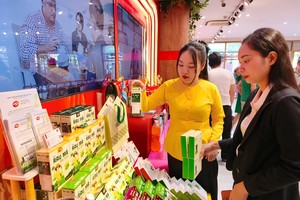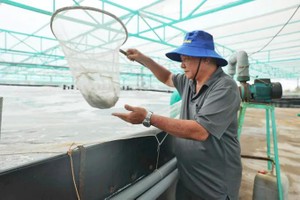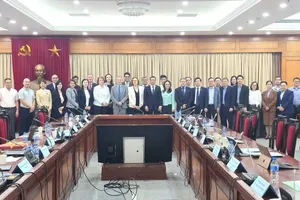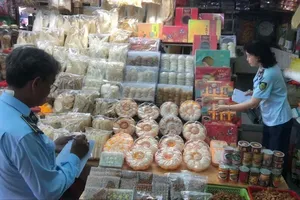 Consumers go shopping at Co.opmart. (Photo: SGGP)
Consumers go shopping at Co.opmart. (Photo: SGGP)
Since 2002, HCMC has been the first locality in the country to initiate and continuously implement the market stabilization program. Currently, the program has created spread, bringing practical benefits to businesses and consumers in HCMC. It has been replicated and implemented in most provinces and cities nationwide.
Over the past 20 years, the program, with many practical solutions, has ensured social security and stabilized the supply and prices of essential items to serve consumers. Especially, from the principle of fixed price, the program has now adopted flexible and timely price adjustments, capable of leading the market and ensuring the interests of businesses and consumers. The prices of goods participating in the program are always 5-10 percent lower than the market.
The program has helped prevent speculation, hoarding of goods, and overcharging for illicit profit and limited the situation of arbitrarily raising prices. Thereby, it has contributed to stabilizing commodity prices, controlling inflation, and keeping the city's consumer price index (CPI) lower than the national average.
Mr. Nguyen Anh Duc, General Director of the HCMC Union of Trading Cooperatives (Saigon Co.op), said that during the time participating in stabilizing the market, the total volume of Saigon Co.op's price-stabilized goods reached an average of 10,000 tons per year. Of which, market-stabilized essential goods accounted for 70-80 percent. Compared to the first year of participation in the program, up to now, Saigon Co.op's stabilized product output has increased by eight times, with the proportion of Vietnamese goods surging from 80 percent to over 90 percent in the commodity structure. The number of stabilized points of sale was also expanded to many other provinces and cities, increasing from an initial 17 points of sale to more than 600 nationwide.
Mr. Nguyen Dang Phu, Deputy General Director of Vietnam Livestock Industry Joint Stock Company (VISSAN), said the program has proven to be one of the effective tools to regulate the market through balancing supply and demand, increasing the efficiency of goods circulation, and building a healthy competitive environment, helping to curb inflation not only for HCMC but also for the whole country. Most enterprises participating in the program have a large scale and account for a high market share. They are reputable brands and are trusted and chosen by consumers.
“The program has helped create a bridge between manufacturers and distributors and consumers. This association helps consumers have the opportunity to access high-quality goods at reasonable prices and creates conditions for stable production and consumption, ensuring benefits for producers, thereby creating a stable and sustainable supply for the market. Moreover, by participating in the market stabilization program, businesses are given priority to introduce to supply market-stabilized goods into the program's existing network of points of sale and connect to supply goods to places, such as traditional markets, hospitals, schools, and collective kitchens. From there, consumers have timely access to the source of goods at reasonable prices," Mr. Nguyen Dang Phu added.
Over the past 20 years, the program, with many practical solutions, has ensured social security and stabilized the supply and prices of essential items to serve consumers. Especially, from the principle of fixed price, the program has now adopted flexible and timely price adjustments, capable of leading the market and ensuring the interests of businesses and consumers. The prices of goods participating in the program are always 5-10 percent lower than the market.
The program has helped prevent speculation, hoarding of goods, and overcharging for illicit profit and limited the situation of arbitrarily raising prices. Thereby, it has contributed to stabilizing commodity prices, controlling inflation, and keeping the city's consumer price index (CPI) lower than the national average.
Mr. Nguyen Anh Duc, General Director of the HCMC Union of Trading Cooperatives (Saigon Co.op), said that during the time participating in stabilizing the market, the total volume of Saigon Co.op's price-stabilized goods reached an average of 10,000 tons per year. Of which, market-stabilized essential goods accounted for 70-80 percent. Compared to the first year of participation in the program, up to now, Saigon Co.op's stabilized product output has increased by eight times, with the proportion of Vietnamese goods surging from 80 percent to over 90 percent in the commodity structure. The number of stabilized points of sale was also expanded to many other provinces and cities, increasing from an initial 17 points of sale to more than 600 nationwide.
Mr. Nguyen Dang Phu, Deputy General Director of Vietnam Livestock Industry Joint Stock Company (VISSAN), said the program has proven to be one of the effective tools to regulate the market through balancing supply and demand, increasing the efficiency of goods circulation, and building a healthy competitive environment, helping to curb inflation not only for HCMC but also for the whole country. Most enterprises participating in the program have a large scale and account for a high market share. They are reputable brands and are trusted and chosen by consumers.
“The program has helped create a bridge between manufacturers and distributors and consumers. This association helps consumers have the opportunity to access high-quality goods at reasonable prices and creates conditions for stable production and consumption, ensuring benefits for producers, thereby creating a stable and sustainable supply for the market. Moreover, by participating in the market stabilization program, businesses are given priority to introduce to supply market-stabilized goods into the program's existing network of points of sale and connect to supply goods to places, such as traditional markets, hospitals, schools, and collective kitchens. From there, consumers have timely access to the source of goods at reasonable prices," Mr. Nguyen Dang Phu added.
 Consumers go shopping at MM Mega Market. (Photo: SGGP)
Consumers go shopping at MM Mega Market. (Photo: SGGP)
According to the opinion of many participants in the workshop, to further improve the program's effectiveness, the city should strengthen regional linkages to have a larger supply and control better the quality and food safety. The list of goods in the program also needs to be expanded and flexible for each time and added items related to disease prevention. HCMC needs to mobilize all resources and various participants to join the program and improve quantity and quality. “Creating favorable conditions for more enterprises and other provinces and cities to join the market stabilization program not only helps the program spread quickly, strongly, and effectively but also contributes to controlling inflation and ensuring social security on a broader scale," the representative of MM Mega Market proposed. According to Ms. Ly Kim Chi, Chairwoman of the Food and Foodstuff Association of HCMC, in the context of the Covid-19 pandemic and the high level of commodity prices in the world, which directly affects prices and domestic purchasing power, stabilizing the domestic market through the market stabilization program is crucial. The program has promoted positive effects in HCMC and contributed significantly to the stability and the balance of supply and demand in the Southern region. However, to increase the effectiveness of the program, enterprises expect departments and agencies to work with traditional markets to bring price-stabilized goods into this distribution channel. At the same time, they should support retail businesses through their distribution systems to approach and promote the introduction of price-stabilized goods to professional customer groups, such as restaurants, hotels, and companies, so that consumers in many places can use price-stabilized goods conveniently at good prices. At the same time, departments and agencies need to support connecting all stages in the supply chain, from raw materials and production to processing, transportation, and distribution, to join and agree to cut a part of profits to share difficulties among businesses, as well as with consumers. As a result, the effectiveness of the market stabilization program will be enhanced, creating a breakthrough, and will be replicated. The city should strengthen the program's brand identity to help people easily identify price-stabilized goods.
























